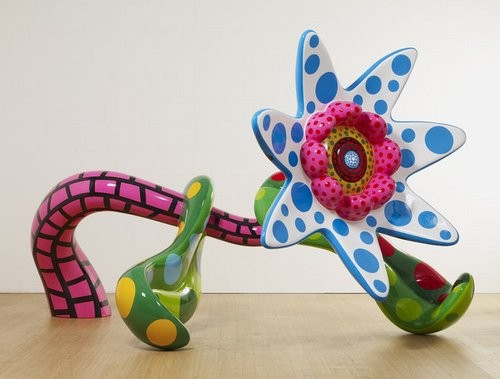Yayoi Kusama
07 Oct - 13 Nov 2010
YAYOI KUSAMA
"Flowers That Bloom Tomorrow"
7 Oct - 13 Nov 2010
Victoria Miro is delighted to present an ensemble of three new flower sculptures by Yayoi Kusama.
The giant triffid-like flora will unfold in all their psychedelic glory, against the backdrop of the Gallery's canalside garden creating a surreal landscape of nature and artifice. Enormous clusters of sinewy stems in bright shades of pink, green, blue, red, and yellow - polka dotted and netted - anchor enormous multihued blooms. These massive sculptures are fabricated in fiberglass-reinforced plastic and painted in high impact-hued urethane to shiny perfection. Kusama's preoccupation with the infinite and sublime to be found in pattern and repetition date back to her earliest paintings from the 1950s. However, it is in these most recently developed works - which encapsulate the surreal and the instinctual within the pop and the decorative - that we find an extension of Kusama's practice into her ninth decade that is as fresh and provocative as ever.
Yayoi Kusama's iconic work Narcissus Garden (1966-) will be installed in the large pond of Tuileries Gardens as part of the Louvre's Sculpture Programme for FIAC this year from 21 - 24 October.
Narcissus Garden dates back to 1966, when Kusama first participated in the 33rd Venice Biennale. The work comprised hundreds of mirrored spheres outdoors in what she called a 'kinetic carpet'. As soon as the piece was installed, Kusama began selling each individual sphere for $2, until the Biennale organisers put an end to her enterprise. Perhaps one of Kusama's most notorious works, Narcissus Garden was as much about the promotion of the artist through the media as it was an opportunity to offer a critique of the mechanisation and commodification of the art market. Various versions of Narcissus Garden have been presented worldwide at venues Kunstverein Braunschweig, 2003 and as part of the Whitney Biennial in Central Park, New York in 2004 and now in Paris.
Yayoi Kusama will be the subject of a solo presentation of new works by Victoria Miro at FIAC (21 - 24 October) which will centre on three large new aluminum pumpkins.
Kusama's acclaimed presentation in the Japanese pavilion at the Venice Biennale in 1993 - which consisted of a mirrored room filled with tiny pumpkin sculptures in which she sat in colour coordinated magician's attire - marked the beginning of the artist's preoccupation with the pumpkin motif. Following the Biennale she went on to produce a huge, yellow pumpkin sculpture covered with an optical pattern of black dots. This pumpkin came to represent for her a kind of alter ego or self-portrait and remains one of her signature series of works. In this new series of aluminum pumpkins the surface of the pumpkin becomes a mirror punctuated with holes that allow the view to look through the sculptures, which are painted in a number of solid hues.
"Flowers That Bloom Tomorrow"
7 Oct - 13 Nov 2010
Victoria Miro is delighted to present an ensemble of three new flower sculptures by Yayoi Kusama.
The giant triffid-like flora will unfold in all their psychedelic glory, against the backdrop of the Gallery's canalside garden creating a surreal landscape of nature and artifice. Enormous clusters of sinewy stems in bright shades of pink, green, blue, red, and yellow - polka dotted and netted - anchor enormous multihued blooms. These massive sculptures are fabricated in fiberglass-reinforced plastic and painted in high impact-hued urethane to shiny perfection. Kusama's preoccupation with the infinite and sublime to be found in pattern and repetition date back to her earliest paintings from the 1950s. However, it is in these most recently developed works - which encapsulate the surreal and the instinctual within the pop and the decorative - that we find an extension of Kusama's practice into her ninth decade that is as fresh and provocative as ever.
Yayoi Kusama's iconic work Narcissus Garden (1966-) will be installed in the large pond of Tuileries Gardens as part of the Louvre's Sculpture Programme for FIAC this year from 21 - 24 October.
Narcissus Garden dates back to 1966, when Kusama first participated in the 33rd Venice Biennale. The work comprised hundreds of mirrored spheres outdoors in what she called a 'kinetic carpet'. As soon as the piece was installed, Kusama began selling each individual sphere for $2, until the Biennale organisers put an end to her enterprise. Perhaps one of Kusama's most notorious works, Narcissus Garden was as much about the promotion of the artist through the media as it was an opportunity to offer a critique of the mechanisation and commodification of the art market. Various versions of Narcissus Garden have been presented worldwide at venues Kunstverein Braunschweig, 2003 and as part of the Whitney Biennial in Central Park, New York in 2004 and now in Paris.
Yayoi Kusama will be the subject of a solo presentation of new works by Victoria Miro at FIAC (21 - 24 October) which will centre on three large new aluminum pumpkins.
Kusama's acclaimed presentation in the Japanese pavilion at the Venice Biennale in 1993 - which consisted of a mirrored room filled with tiny pumpkin sculptures in which she sat in colour coordinated magician's attire - marked the beginning of the artist's preoccupation with the pumpkin motif. Following the Biennale she went on to produce a huge, yellow pumpkin sculpture covered with an optical pattern of black dots. This pumpkin came to represent for her a kind of alter ego or self-portrait and remains one of her signature series of works. In this new series of aluminum pumpkins the surface of the pumpkin becomes a mirror punctuated with holes that allow the view to look through the sculptures, which are painted in a number of solid hues.

